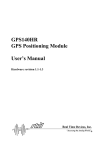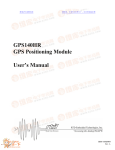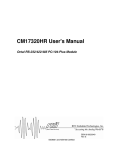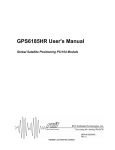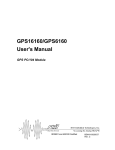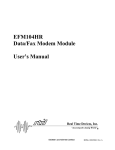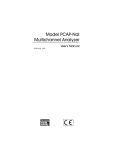Download GPS140HR User`s Manual - RTD Embedded Technologies, Inc.
Transcript
GPS140HR User's Manual Global Satellite Positioning PC/104 Module BDM-610020004 Rev. A ISO9001 and AS9100 Certified GPS140HR User's Manual RTD EMBEDDED TECHNOLOGIES, INC. 103 Innovation Blvd State College, PA 16803-0906 Phone: +1-814-234-8087 FAX: +1-814-234-5218 E-mail [email protected] [email protected] Web Site http://www.rtd.com Page 2 of 30 Manual Revision History Rev A New manual naming method Manual restructured Published by: RTD Embedded Technologies, Inc. 103 Innovation Boulevard State College, PA 16803 Copyright 2005 by RTD Embedded Technologies, Inc. All rights reserved The RTD Embedded Technologies Logo is a registered trademark of RTD Embedded Technologies. dspModule, cpuModule, and utilityModule are trademarks of RTD Embedded Technologies. PC/104, PC/104-Plus, and PCI-104 are registered trademarks of the PC/104 Consortium. All other trademarks appearing in this document are the property of their respective owners. Page 3 of 30 Table of Contents Introduction.................................................................................................................................... 7 Product Overview......................................................................................................................... 7 Board Features ............................................................................................................................ 7 GPS140HR Features............................................................................................................ 7 GPS Receiver ....................................................................................................................... 7 I/O Interfaces................................................................................................................................ 7 16C550 Compatible UART ................................................................................................... 8 Connector Description .......................................................................................................... 8 Available Options ......................................................................................................................... 8 Getting Technical Support ........................................................................................................... 8 Board Connections ..................................................................................................................... 10 Connector and Jumper Locations .............................................................................................. 10 External I/O Connections ........................................................................................................... 10 GPS Receiver Connector (to GPS module) ........................................................................... 11 Connector J1 – Differential GPS Signal Input Connector ...................................................... 11 Connector J3 – Utility I/O Connector...................................................................................... 11 Jumpers ..................................................................................................................................... 12 Base Address Jumpers (Default: 2E8) .................................................................................. 13 IRQ Jumpers (Default: IRQ 5 closed, G Jumper closed) ...................................................... 15 Reserved IRQs ................................................................................................................... 15 The G Jumper ..................................................................................................................... 16 GPS Configuration (Default: ROM = closed, NMEA closed) ................................................ 16 RST Jumper – Default Open .............................................................................................. 17 ROM Jumper – Default Closed........................................................................................... 17 NMEA Jumper – Default Closed......................................................................................... 17 Active Antenna Supply (Default: +5V)................................................................................... 18 Board Installation ........................................................................................................................ 19 Installing the Hardware .............................................................................................................. 19 Static Precautions .................................................................................................................. 19 Page 4 of 30 Steps for Installing.................................................................................................................. 19 Configuring Software ................................................................................................................. 20 Hardware Description ................................................................................................................. 21 Overview .................................................................................................................................... 21 Block Diagram............................................................................................................................ 21 The NAVMAN Jupiter GPS Receiver Module............................................................................ 22 Antenna...................................................................................................................................... 22 UART Channel ........................................................................................................................... 22 Pulse Outputs............................................................................................................................. 23 1 pulse/sec output and LED ................................................................................................... 23 10 KHz output......................................................................................................................... 23 Fuses...................................................................................................................................... 23 Software Programming ............................................................................................................... 24 Device I/O Map .......................................................................................................................... 24 Interrupts .................................................................................................................................... 24 Operation ................................................................................................................................... 25 GPS140HR Specifications .......................................................................................................... 26 GPS Receiver Specifications ..................................................................................................... 26 Physical Attributes .................................................................................................................. 26 Operational ............................................................................................................................. 26 RF Signal Environment .......................................................................................................... 26 Environmental ........................................................................................................................ 26 UART ......................................................................................................................................... 27 Fuses ......................................................................................................................................... 27 GPS140HR Operating Conditions ............................................................................................. 27 Additional Information ................................................................................................................ 28 NAVMAN Jupiter GPS Receiver ................................................................................................ 28 NMEA-0183 v2.01 Standard ...................................................................................................... 28 NAVMAN Binary Message Format ............................................................................................ 28 Serial Port Programming............................................................................................................ 28 Page 5 of 30 Interrupt Programming ............................................................................................................... 28 GPS Antenna Specifications...................................................................................................... 29 Limited Warranty ......................................................................................................................... 30 Page 6 of 30 Introduction Product Overview The GPS140HR is designed to provide a global positioning system (GPS) for PC/104-based systems. Included on the GPS140HR is the NAVMAN Jupiter TU30-D400 series GPS receiver (part number TU30-D410-021). The GPS140HR has an onboard UART chip that permits communication with the GPS receiver module over the PC/104 bus without using other serial ports in the PC/104 system. The GPS140HR supports NAVMAN binary protocol and National Marine Electronics Association (NMEA-0183) v2.01 messages. Board Features GPS140HR Features o o o o o o o o o o Direct connection to onboard GPS receiver module Choice of GPS message formats NAVMAN binary protocol National Marine Electronics Association (NMEA-0183) v2.01 messages 12-satellite parallel tracking GPS receiver with fast response Differential GPS support with external correction source Onboard UART with flexible I/O and IRQ selection Supports active (+5V or +12V) and passive antennas Right angle OSX connector Alignment with Coordinated Universal Time (UTC) Status LED indicates 1 pulse/sec time mark output aligns with the UTC second 10 kHz square clock aligned with UTC second is available as an output from the board Backup battery to store GPS receiver data while powered off PC/104 compliant GPS Receiver The GPS140HR Global Positioning System (GPS) board uses a GPS receiver module for satellite signal reception. The low power receiver outputs may use either ASCII based NMEA-0182 data protocol or NAVMAN binary protocol depending upon the module’s selectable jumper settings. The GPS receiver supports 12-satellite parallel-tracking as well as a fast acquisition and reacquisition response. I/O Interfaces The GPS140HR can be controlled and monitored by software through the dedicated serial port UART of the module. A utility I/O connector provides a connection to the onboard GPS 1 pulse/sec time mark as well as an onboard 10 KHz timing clock signal. A +12V pin on the utility connector is available to supply power to an active antenna from an external source. If +12V is available on the PC/104 bus, this antenna supply input should not be used. Page 7 of 30 16C550 Compatible UART The GPS receiver module communicates through a dedicated UART channel allowing other serial ports in the system to be free for the user. The UART is recognized by all x86 operating systems, and does not require a special communication driver to receive data from the GPS receiver. The base address and interrupt of the UART channel can be changed with onboard jumpers. For information on how to install the jumpers, please refer to the “Board Connections” chapter of this manual. Connector Description The GPS receiver antenna interface is a right angle OSX type miniature coaxial connector. Connect your antenna directly to the GPS140HR antenna connector, or use a short cable inside your enclosure to connect to a feed through connector to allow connection of the antenna to the wall of your enclosure. All other I/O connections to the GPS140HR use 0.1” header type terminals. Available Options The GPS140 is available as a starter kit, bundled with an active antenna. It may also be purchased as an IDAN module for integration into an RTD IDAN system. The following is a summary of the different GPS140 configurations: Part Number Description GPS140HR GPS140HR SK-GPS140HR GPS140HR with an active antenna IDAN-GPS140HRS GPS140HR mounted in an IDAN frame IDAN-SK-GPS140HRS GPS140HR mounted in an IDAN frame with an active antenna For antenna specifications, please refer to the “Additional Information” chapter of this manual. Getting Technical Support If you are having problems with your system, please try the following troubleshooting steps: • Simplify the System – Remove modules one at a time from your system to see if there is a specific module that is causing a problem. • Swap Components – Try replacing parts in the system one-at-a-time with similar parts to determine if a part is faulty or if a type of part is configured incorrectly. If problems persist, or you have questions about configuring this product, obtain the base address and IRQ settings of the GPS140HR and other modules in the system. After you have this information, contact RTD Embedded Technologies via the following methods: Phone: +1-814-234-8087 Page 8 of 30 E-Mail: [email protected] Be sure to check the RTD web site (http://www.rtd.com) frequently for product updates, including newer versions of the board manual and application software. Page 9 of 30 Board Connections Connector and Jumper Locations The following diagram shows the location of all connectors and jumpers on the GPS140HR. Future revisions of the GPS140HR may have cosmetic differences. For a description of each jumper and connector, refer to the following sections. GPS140HR Connector and Jumper Locations Backup Battery GPS Correction Signal Input (J1) GPS Configuration Jumpers GPS Receiver Module Active Antenna Supply Jumpers Base Address Jumpers IRQ Jumpers and G Jumper Utility I/O Connector (J3) PC/104 (ISA) Connector External I/O Connections The following sections describe the external I/O connections of the GPS140HR. Page 10 of 30 GPS Receiver Connector (to GPS module) The GPS receiver module connects to the 2mm female socket connector with pins facing the PCB. The table below shows the pin connections of the GPS receiver interface to the GPS140HR. Pin 1 3 5 7 9 11 13 15 17 19 Description Antenna +V +3.6V battery backup GPS RESET NMEA_SEL NC SER_OUT GND DIFF_GPS_IN GPS 1 Pulse/Sec Pin 2 4 6 8 10 12 14 16 18 20 Description GPS +5V Supply NC NC ROM_SEL GND SER_IN NC GND GND 10 KHz Connector J1 – Differential GPS Signal Input Connector A differential GPS correction signal input can be applied to the GPS140HR for precise positioning using the RTCM SC-04 differential signal source. The signal levels on this input are RS232. The pin connections are shown below. Pin 1 3 5 7 9 Description NC DGPS_IN NC NC GND Pin 2 4 6 8 10 Description NC NC NC NC GND Connector J3 – Utility I/O Connector External power and I/O signals connect to your GPS140HR through header connector J3. Page 11 of 30 Pin 1 3 5 7 9 Description +5V SER_OUT SER_IN BATT in: +3.6V GND Pin 2 4 6 8 10 Description +12V antenna supply input 1 pulse/sec output 10 KHz output GND GND If you are using a +12V active antenna you must either have a +12V present from the PC/104 bus or you can supply it through pin 2 of the utility connector. The +12V input pin should not be used if +12V is present on the PC/104 bus. If the onboard GPS SRAM backup battery is not in use, pin 7 may be connected to a +3.6V battery to provide a backup for the GPS SRAM. This pin should not be connected if the onboard battery is in use. Note: Connecting the +3.6V battery backup pin can damage the GPS140HR if the onboard battery is being used. This pin should only be used if the onboard battery is not in use. The 1 pulse/sec and 10 KHz outputs are buffered using HCT04 buffers. The SER_OUT signal present in pin 3 is the TTL-level output of the GSP receiver. This pin can be used to connect to other system devices that require information from the GPS receiver. The SER_OUT and SER_IN pins refer to data leaving and entering the GPS receiver module respectively. The SER_IN pin carries commands to the receiver while SER_OUT transmits data from the receiver to the UART chip. These pins are used to transmit and receive messages for both the NMEA-0183 v2.01 and NAVMAN binary protocols. Note: The SER_OUT (pin 3) signal is a TTL signal that comes directly from the GPS module on the GPS140HR. This signal does not come from the onboard UART chip, and cannot be used as a standard serial port. Jumpers The following sections describe the jumper configuration options available on the GPS140HR. For a reference that shows the location of each set of jumpers, refer to the diagram of the GPS140HR at the beginning of this chapter. The default factory jumper settings are listed in the following table: Page 12 of 30 Jumper Description Base Address Jumpers IRQ Jumpers GPS Configuration Jumpers Antenna Supply Voltage Note: Default Factory Setting to 2E8h 5 and G jumper closed closed; NMEA closed to +5V Set IRQ ROM Set The antenna supply selection jumper must be removed if using a passive antenna. Driving a passive antenna may cause permanent damage to the antenna. Base Address Jumpers (Default: 2E8) The base address selection jumpers (A3 through A8) allow you to set the base address of the serial port UART of the GPS140HR. Any software that accesses the board will do so through reads and writes to the I/O address set by the jumpers. To function properly, the I/O address the software is expecting must match the base address set by the jumpers. As shown in the figure below, A3 is located at the top end of the jumper block (towards the PC/104 connector), while A8 is located at the bottom end (away from the PC/104 connector): The table on the following pages shows the possible base address settings for the GPS140HR. All base addresses are in hexadecimal. An ‘X’ indicates a closed jumper, while an empty cell indicates an open jumper. Base Address (Hexadecimal) 200 208 210 218 220 228 230 238 240 248 250 258 260 A8 A7 Jumpers A6 A5 A4 A3 X X X X X X X X X X X X Page 13 of 30 X X X X X X X X X X 268 270 278 280 288 290 298 2A0 2A8 2B0 2B8 2C0 2C8 2D0 2D8 2E0 2E8 2F0 2F8 300 308 310 318 320 328 330 338 340 348 350 358 360 368 370 378 380 388 390 398 3A0 3A8 3B0 3B8 3C0 3C8 3D0 3D8 3E0 3E8 3F0 3F8 X X X X X X X X X X X X X X X X X X X X X X X X X X X X X X X X X X X X X X X X X X X X X X X X X X X X X X X X X X X X X X X X X X X X X X X X X X X X X X X X X X X X X X X X X X X X X X X X X X X X X X X X X X X X X X X X X X X X X X X X X X X X X X X X X X X X X X X X X X X X X X X X X X X X X X X X X X X X X X X X X X X X X X X X X X By default, the GPS140HR comes configured with a base address of 0x2E8. Page 14 of 30 When selecting a base address for the GPS140HR, please observe the following guidelines: • Every device in your PC/104 system must have a unique base address! When selecting a base address for the GPS140HR, make certain that it does not conflict with any other devices. • Base addresses 0x3F8 and 0x2F8 are typically used by serial ports COM1 and COM2, respectively. If you wish to use one of those base addresses, you will need to disable the conflicting serial port. • Some operating systems expect UART devices to be located at the standard serial port base addresses (0x3F8, 0x2F8, 0x3E8, and 0x2E8). Setting your GPS140HR to one of these addresses can make system setup and configuration easier. IRQ Jumpers (Default: IRQ 5 closed, G Jumper closed) The IRQ selection jumpers allow you to set the IRQ used by the serial port UART of the GPS140HR. The GPS140HR can be configured for any one of the following IRQs: 2, 3, 4, 5, 6, 7, 10, 11, 12, 14, or 15. The IRQ can be set by closing the appropriately labeled jumper on the board. The IRQ jumpers are located next to the PC/104 bus, as shown in the diagram at the beginning of this chapter. Note: Typically IRQs can not be shared; although there are some special cases (see “The G Jumper” later in this document). In general, the IRQ you select should not be used by any other devices in your system. Reserved IRQs Some of the IRQ choices on the GPS140HR may already be used by your CPU’s onboard peripherals. Some commonly-used IRQs are: • IRQ 2 is typically reserved for cascading interrupts, and therefore unavailable on most AT class systems. • IRQ 3 or 4 may be set to a serial port in your system. You may need to disable a serial port in your system prevent an IRQ conflict. • IRQ 5 or 7 may be used by the CPU’s parallel port. Check your CPU’s configuration to avoid a conflict. • IRQ 12 is used by the PS/2 mouse. To use this IRQ, you will need to remove the PS/2 mouse from the system. Some CPUs also require a BIOS setting to disable the PS/2 mouse controller. • IRQ 14 is used by the primary IDE controller. To use this IRQ, you will need to disable the primary IDE controller. Page 15 of 30 • IRQ 15 is used by the secondary IDE controller. To use this IRQ, you will need to disable the secondary IDE controller. The G Jumper The GPS140HR supports shared interrupts as defined by the PC/104 specification. This sharing is accomplished via the G jumper, which is located adjacent to the IRQ jumpers. The G jumper installs a 1K-ohm resistor to pull the signal to the low state, allowing an interrupt to drive the signal high. To share interrupts, configure the devices for the same IRQ, and close the G jumper on one (and only one) of the devices. When using interrupt sharing, consider the following guidelines: • An interrupt can only be shared if all devices on the IRQ support it. If you have two sharing and one non-sharing device on the same IRQ, it will not work. • To share interrupts, the system’s drivers and operating system must support it. The Interrupt Service routines must be written to check all devices on an IRQ when the interrupt is detected. Many popular operating systems do not support interrupt sharing for ISA devices. Note: If you are not sharing interrupts, make sure you leave the GPS140HR’s G jumper closed! GPS Configuration (Default: ROM = closed, NMEA closed) The jumper blocks illustrated below is used to configure the mode of operation of the GPS receiver module. The NMEA jumper is closest to the PC/104 connector while the RST jumper is farther away from the PC/104 connector. The location of these jumpers can also be found in the diagram at the beginning of this chapter. Page 16 of 30 Default Jumper Settings A general description of the jumpers can be found below. For a detailed description of the jumpers, please refer to the manual for the NAVMAN Jupiter GPS Receiver. The webpage of the GPS receiver manufacture is listed in the appendix. RST Jumper – Default Open To reset the GPS receiver, this signal must be pulled low by installing the jumper for at least 150ns during system power up. When the system has booted, the jumper may be removed to de-assert the GPS receiver’s reset signal. Note that the signal is a master reset, and will force the GPS receiver to search for satellites. Note: If the ROM and NMEA jumpers are closed, the protocol and baud rate settings before the last power down will be used when the reset signal is de-asserted. ROM Jumper – Default Closed To use satellite tracking information, navigation settings, baud rate, and the message protocol settings before the last power down, this signal must be pulled high by installing a jumper across the ROM pins. When the jumper is open (removed), this pin is pulled low and the GPS receiver does not use tracking history stored in the EEPROM on the receiver module, but instead searches for satellites. User settings such as the baud rate and message protocol are also lost when the system is booted with this jumper setting. Note: The NMEA jumper must also be closed (installed) to use the baud rate and message protocol settings before the last power down. NMEA Jumper – Default Closed To use the last protocol and baud rate before the last power down, the signal must be pulled high by installing a jumper across the NMEA pins. Removing this jumper pulls the signal low and forces the NMEA mode as the selected protocol at 4800 baud (with no parity, 8 data bits, and 1 stop bit). Note: The ROM jumper must also be closed (installed) to use the baud rate and message protocol settings before the last power down. Page 17 of 30 Active Antenna Supply (Default: +5V) Active GPS antennas require a supply to drive the antenna. If using a passive antenna, this jumper should be removed. Typical supply voltages for active antennas are +5V and +12V. Set this jumper to +5V or +12V according to the requirements of your active antenna. If you are using a +12V active antenna you must either have a +12V present from the PC/104 bus or you can supply it through pin 2 of the utility connector. Note: The supply selection jumper must be removed if using a passive antenna. Driving a passive antenna may cause permanent damage to the antenna. Page 18 of 30 Board Installation Installing the Hardware The GPS140HR can be installed into a PC/104 or PC/104-Plus stack. It can be located almost anywhere in the stack, above or below the CPU. Note: If the GPS140HR is installed in a PC/104-Plus system, be sure to not break the chain of PCI devices (such as stacking the GPS140HR between two PC/104-Plus boards). Static Precautions Keep your board in its antistatic bag until you are ready to install it into your system! When removing it from the bag, hold the board at the edges, and do not touch the components or connectors. Handle the board in an antistatic environment, and use a grounded workbench for testing and handling of your hardware. Steps for Installing 1. Shut down the PC/104 system and unplug the power cord. 2. Ground yourself with an anti-static strap. 3. Set the Base Address and IRQ jumpers as described in the previous chapter. 4. Line up the pins of the GPS140HR’s PC/104 connector with the PC/104 bus of the stack and gently press the board onto the stack. The board should slide into the matching PC/104 connector easily. Do not attempt to force the board, as this can lead to bent/broken pins. 5. If an external antenna is required, attach it to the OSX/MSX connector. If the antenna is an active antenna, set the voltage to +5V or +12V with the active antenna supply jumper. Remove the active antenna supply jumper if using a passive antenna. 6. If any boards are to be stacked above the GPS140HR, install them. 7. Attach any necessary cables to the PC/104 stack. 8. Re-connect the power cord and apply power to the stack. 9. If the system has a PCI bus, enter the BIOS setup and reserve the GPS140HR’s IRQ as a Legacy ISA resource. 10. Apply power to the system, and verify that all of the hardware is working properly. Once power is applied, the GPS receiver will automatically initialize. A blinking LED will indicate activity on the GPS receiver. Page 19 of 30 Configuring Software The GPS140HR uses a standard serial port UART for host communication. Therefore, you must “install” a serial port under your host operating system for the GPS140HR to be recognized. If the GPS140HR was installed using a standard serial port base address (0x3F8, 0x2F8, 0x3E8, or 0x2E8), your operating system may detect the GPS140HR’s UART automatically. If the GPS140HR was not auto-detected, or if it was configured with a non-standard base address, the serial port will need to be configured manually. Beyond the IRQ and base address, you may also need to configure the serial port parameters. The UART interface is controlled by jumper settings. The procedure for configuring the serial port will vary depending on the operating system. Consult the operating system’s documentation for instructions on how to do this. Page 20 of 30 Hardware Description Overview This chapter describes the major hardware building blocks of the GPS140HR. The components discussed in this chapter include: • The GPS Receiver Module • Antenna • UART Channel • Pulse Outputs Block Diagram Below is a block diagram of the GPS140HR. Page 21 of 30 The NAVMAN Jupiter GPS Receiver Module The GPS140 includes an onboard NAVMAN Jupiter GPS Receiver Module (part number TU30D410-021). This 12-channel parallel-tracking GPS receiver provides fast Time-To-First-Fix (TTFF) under all startup conditions. While the best TTFF performance is achieved when the time of day and current position estimates are provided by the receiver, the flexible signal acquisitions system takes advantage of the available information to provide fast TTFF. Acquisition is guaranteed under all initialization conditions as long as visible satellites are not obscured. To minimize the TTFF when primary system power is off the GPS140HR maintains the SRAM and the Real Time Clock (RTC) using the onboard battery. In this case the shortest TTFF is achieved by using the RTC time data and prior position data stored in the receiver’s SRAM. The receiver supports 2D operation when less than three satellites are available or when required by operating conditions. Altitude information required for 2D operation is determined by the receiver or may be performed by your application software. Communication to and from the receiver is performed through a serial channel that is connected to the onboard UART. The receiver’s primary serial port outputs navigation data and accepts commands from the OEM application in NMEA-0183 v2.01 format or NAVMAN binary protocol. The secondary serial port (connector J1) is configured to accept DGPS corrections in the RTCM SC-104 format. This manual is not intended to be a GPS handbook. For more information on the GPS receiver module, the NMEA-0183 format, and the NAVMAN binary protocol, please refer to the chapter titled ”Additional Information”. Antenna The GPS receiver can operate from an active or passive GPS antenna to receive L1 band frequency GPS carrier signals. Typical cable connections are made with OSX, SMA, and SMB connections. If you connect the antenna directly to your GPS receiver without a feed through connector through your enclosure wall you can select an antenna with an OSX connector to plug into the OSX plug on your receiver module. Refer to the “Jumpers” section of the manual for instructions on providing a voltage to an active antenna. UART Channel GPS data is sent to the host from the receiver through a standard 16C550 compatible UART. All x86 operating systems will recognize and support this serial communication device. The GPS140HR uses its own onboard serial port and will not reserve serial port resources from the system. The I/O base address and interrupt for this serial port can be flexibly set as described in previous chapters of this manual. After setting the base address and IRQ, you can use any communication software package or terminal program to connect to your GPS140HR UART. The oscillator frequency is 1.8432MHz. A reference for programming serial port UARTs can be found in the chapter titled “Additional Information” at the end of this manual. The UART is connected as a NULL-MODEM device. Only the TXD and RXD lines of the UART are connected to the GPS receiver chip. Page 22 of 30 Pulse Outputs 1 pulse/sec output and LED The GPS receiver on the GPS140 generates a 1 pulse/sec buffered TTL level output that is synchronized with the Coordinated Universal Time (UTC) second. The rising edge of this signal is synchronized with the UTC within 50 ns. The receiver software produces a data message containing the UTC time associated with each time mark pulse. This output signal is connected to the LED as shown below. 1 pulse/sec output indicator LED 10 KHz output A 10 KHz clock-output that is synchronized to the Coordinated Universal Time (UTC) 1 pulse/sec output is also generated by the GPS receiver. This signal is buffered with a HCT04 buffer, and can be used as an output to synchronize other devices. Fuses A 2A fuse (yellow) protects the GPS receiver from error conditions. The active antenna is fused with a 125mA fuse (green). These fuses are on the left edge of the board. Page 23 of 30 Software Programming Device I/O Map The GPS140HR is an I/O mapped device. The memory map of the GPS140HR occupies eight bytes of host PC I/O space. This window is freely selectable by the user as defined by the base address jumper settings. After setting the base address the user has access to the internal resources of the GPS140HR control logic. These resources are not described in detail, since they are mapped as a standard PC serial port. A reference for programming serial port UARTs can be found in the chapter titled “Additional Information” at the end of this manual. The following table shows the general I/O map of the GPS140HR: Address Base Addr Base Addr + 1 Base Addr + 2 Base Addr + 3 Base Addr + 4 Base Addr + 5 Base Addr + 6 Register TXD RXD BAUD div. low BAUD div. high IRQ enable IRQ ID Line control Modem control Line status Modem status Direction Out In Comments Only if control reg. Bit 7 = 0 Only if control reg. Bit 7 = 0 Only if control reg. Bit 7 = 1 Only if control reg. Bit 7 = 1 Only if control reg. Bit 7 = 0 Interrupts Interrupts are used to notify the host CPU that an event happened on a particular device. In general, interrupts are more efficient than a polling technique, where the CPU must query the device status at regular intervals. Devices that use interrupts have a special connection to the CPU, called an interrupt request line (IRQ). When the device needs the CPUs attention, it asserts the IRQ line. Once the interrupt has been processed, the IRQ line is de-asserted. The GPS140HR will use the jumper-selected interrupt. However, it will not actually generate interrupts unless the Interrupt Enable register has been properly programmed. Since the GPS140HR has a 16C550 UART, it supports all of the standard serial port interrupt events. These events include: • Received data available • Transmit buffer empty • Line Status Register change • Modem Status Register change A detailed explanation of serial port interrupts is beyond the scope of this manual. For more information, consult a serial port programming reference. The chapter titled “Additional Information” lists some resources to help the user. Page 24 of 30 Note: When the UART clock is running at a higher frequency, transmit/receive interrupts will happen more frequently. Many operating systems can not process interrupts quickly enough to handle this load. When developing your software, be sure to consider the operating system’s limitations. Operation When properly configured, the GPS receiver will begin transmission of navigation data to the UART chip on the GPS140. During operation, the GPS receiver accepts commands in the NAVMAN binary message form or in NMEA formatted message protocol. The accepted format depends on the settings of the ROM and NMEA GPS configuration jumpers. These jumpers are explained in the Jumpers section of this manual. The NAVMAN binary message format uses a binary data stream to transmit and receive data. A binary message consists of a header and data, with a checksum value. A header is required for each message, but some messages do not contain data. The NMEA message protocol uses ASCII messages which conform to the NMEA0183 v2.01 specification. A detailed explanation of the NAVMAN binary message format and NMEA-0183 protocol is beyond the scope of this manual. For more information, please refer to the resources listed in the appendix. Page 25 of 30 GPS140HR Specifications GPS Receiver Specifications Physical Attributes o o o Size: 3.6”L x 3.8”W x 0.6”H (90mm L x 96mm W x 15mm H) Weight: 0.24bs (0.10 Kg) Power Consumption: 1.125W @ 5 VDC Typical (NMEA mode in DOS) Operational GPS receiver NAVMAN Jupiter TU30-D410-021 Update rate Once per second Reacquisition 2s typical with a 10s blockage RTCM SC-104 differential compatibility Direct connection to RS232 input Supported data protocols National Marine Electronics Association (NMEA0183) v2.01, or NAVMAN binary protocol Power requirement +5V, preamplifier passthrough up to +12V for active antenna RF Signal Environment RF input 1575.42MHz (L1 band) at levels -130dBW and –163dBW Connector OSX high retention female connector Burnout protection -10dBW signal with a bandwidth of 10MHz centered about the L1 carrier frequency Environmental Cooling Convection Operating temperature -40º to +85ºC Humidity RH up to 95% non-condensing Altitude -1000 to 60.000 ft Maximum Vehicle Dynamic 500m/s acquisition and navigation Vibration Survival 18G peak Page 26 of 30 UART UART compatibility 16C550 Oscillator frequency 1.8432MHz Connection Null Modem Base addresses 32 Interrupts 2, 3, 4, 5, 7, 10, 11, 12, 14 and 15 Fuses GPS receiver 2A Active antenna 125mA GPS140HR Operating Conditions Operating temperature range -40º to +85ºC Storage temperature range -55 C to +125 C Humidity RH up to 95% non-condensing Altitude -1000 to 30.000 ft o Page 27 of 30 o Additional Information NAVMAN Jupiter GPS Receiver For a downloadable datasheet for the Jupiter GPS receiver (part number TU30-D410-021) visit the receiver manufacturer’s website: http://www.navman.com/ NMEA-0183 v2.01 Standard For a complete description on the National Marine Electronics Association (NMEA-0183) v2.01 protocol visit the NMEA website: http://www.nmea.org/ A detailed description of the NMEA data messages supported by the Jupiter GPS receiver can be found in the Zodiac GPS Receiver Family Designer’s Guide. This document is available on the web under the downloads section of the TDC webpage: http://www.tdc.co.uk/ NAVMAN Binary Message Format A detailed description of the serial data interface is contained in the Zodiac GPS Receiver Family Designer’s Guide. This document is available on the web under the downloads section of the TDC webpage: http://www.tdc.co.uk/ Serial Port Programming For more information about programming serial port UARTs, consult the following book: Serial Communications Developer’s Guide By Mark Nielson ISBN: 0764545701 Interrupt Programming For more information about interrupts and writing interrupt service routines, refer to the following book: Interrupt-Driven PC System Design By Joseph McGivern ISBN: 0929392507 Page 28 of 30 GPS Antenna Specifications The RTD part numbers SK-GPS140HR and IDAN-SK-GPS140HRS come with the following active antenna Manufacturer: Matsushita Electric Part number: GPS024OSX01C02 Page 29 of 30 Limited Warranty RTD Embedded Technologies, Inc. warrants the hardware and software products it manufactures and produces to be free from defects in materials and workmanship for one year following the date of shipment from RTD EMBEDDED TECHNOLOGIES, INC. This warranty is limited to the original purchaser of product and is not transferable. During the one year warranty period, RTD EMBEDDED TECHNOLOGIES will repair or replace, at its option, any defective products or parts at no additional charge, provided that the product is returned, shipping prepaid, to RTD EMBEDDED TECHNOLOGIES. All replaced parts and products become the property of RTD EMBEDDED TECHNOLOGIES. Before returning any product for repair, customers are required to contact the factory for an RMA number. THIS LIMITED WARRANTY DOES NOT EXTEND TO ANY PRODUCTS WHICH HAVE BEEN DAMAGED AS A RESULT OF ACCIDENT, MISUSE, ABUSE (such as: use of incorrect input voltages, improper or insufficient ventilation, failure to follow the operating instructions that are provided by RTD EMBEDDED TECHNOLOGIES, "acts of God" or other contingencies beyond the control of RTD EMBEDDED TECHNOLOGIES), OR AS A RESULT OF SERVICE OR MODIFICATION BY ANYONE OTHER THAN RTD EMBEDDED TECHNOLOGIES. EXCEPT AS EXPRESSLY SET FORTH ABOVE, NO OTHER WARRANTIES ARE EXPRESSED OR IMPLIED, INCLUDING, BUT NOT LIMITED TO, ANY IMPLIED WARRANTIES OF MERCHANTABILITY AND FITNESS FOR A PARTICULAR PURPOSE, AND RTD EMBEDDED TECHNOLOGIES EXPRESSLY DISCLAIMS ALL WARRANTIES NOT STATED HEREIN. ALL IMPLIED WARRANTIES, INCLUDING IMPLIED WARRANTIES FOR MECHANTABILITY AND FITNESS FOR A PARTICULAR PURPOSE, ARE LIMITED TO THE DURATION OF THIS WARRANTY. IN THE EVENT THE PRODUCT IS NOT FREE FROM DEFECTS AS WARRANTED ABOVE, THE PURCHASER' S SOLE REMEDY SHALL BE REPAIR OR REPLACEMENT AS PROVIDED ABOVE. UNDER NO CIRCUMSTANCES WILL RTD EMBEDDED TECHNOLOGIES BE LIABLE TO THE PURCHASER OR ANY USER FOR ANY DAMAGES, INCLUDING ANY INCIDENTAL OR CONSEQUENTIAL DAMAGES, EXPENSES, LOST PROFITS, LOST SAVINGS, OR OTHER DAMAGES ARISING OUT OF THE USE OR INABILITY TO USE THE PRODUCT. SOME STATES DO NOT ALLOW THE EXCLUSION OR LIMITATION OF INCIDENTAL OR CONSEQUENTIAL DAMAGES FOR CONSUMER PRODUCTS AND SOME STATES DO NOT ALLOW LIMITATIONS ON HOW LONG AN IMPLIED WARRANTY LASTS, SO THE ABOVE LIMITATIONS OR EXCLUSIONS MAY NOT APPLY TO YOU. THIS WARRANTY GIVES YOU SPECIFIC LEGAL RIGHTS, AND YOU MAY ALSO HAVE OTHER RIGHTS WHICH VARY FROM STATE TO STATE. Page 30 of 30






























